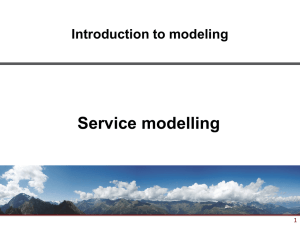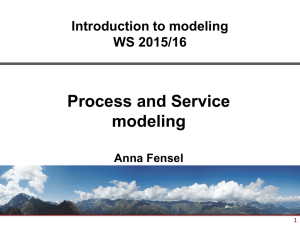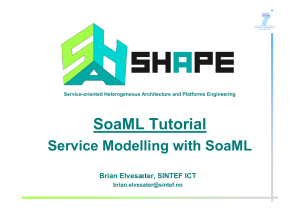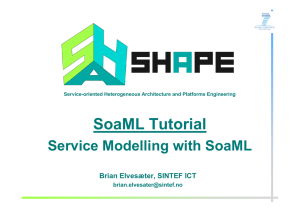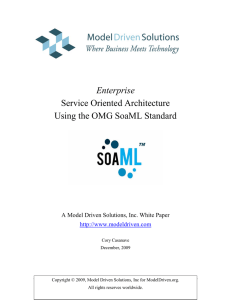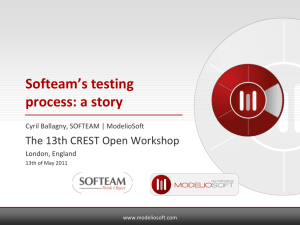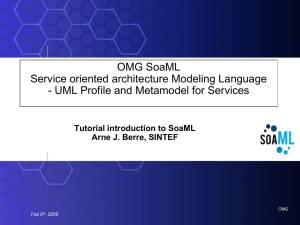SOAML_intro
advertisement
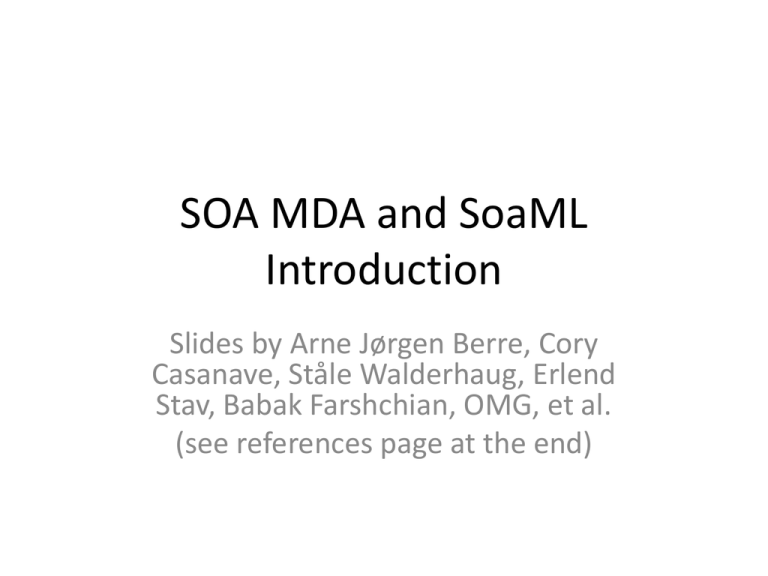
SOA MDA and SoaML Introduction Slides by Arne Jørgen Berre, Cory Casanave, Ståle Walderhaug, Erlend Stav, Babak Farshchian, OMG, et al. (see references page at the end) Plan for SoaML lectures • Now: Introduction to MDD of SOA, and the role of SoaML (1 hour) • 1500-1700 today: SoaML Standard, Process for SoaML-based MDD MDD of enterprise SOA MDA Terms Computation Independent Model Platform Independent Model Technology Specification JMS, JEE, Web Services, .NET WS*, BPEL, XML Schema Customers Copyright © 2009 Data Access Technologies, Inc. Model Driven Solutions May 2009 Line-Of-Sight Logical System Model Technology Services (t-SOA), Components, Costs BPM Interfaces, Messages & Data Agility Refinement & Automation Business Model Goals Enterprise Services (e-SOA) Roles, Collaborations & Interactions Policy Process, Information & Rules Platform Specific Model Business Concerns Computation Independent Model MDA Terms Business Architecture Model (BAM) 2. Business Processes 1. Business Goals 4. Services Architecture 3. Capabilities 5. Service Contracts and Behaviour 6. Model to Model (M2M) Transformation Software Architecture Model (SAM) Platform Independent Model 8. Interfaces and Messages 7. Service Interfaces 9. Service Choreographies 11. Services Orchestration 10. Software Components Platform Specific Model 12. Model to Text (M2T) Transformation PlatformSpecific Model (PSM) Cloud, Web Services, JEE, MAS, P2P/Grid, SWS BPMN BPDM BMM CIM Business Models EPC UPMS 2.0 ? SoaML/UPMS SoaML / UPMS (core) UPMS WSA EDA PIM4 SWS PIM Models Service Variability PIM4 Agents P2P/Grid/ Components PIMs for different Architectural Styles PSM Models WS, WSMO, OWL-S, JACK, JADE, JXTA, OGSA, J2EE, CORBA J2EE, NetWeaver, .Net Realisation Technologies Process vs. artifacts Process (Proprietary) SoaML standard does not define any process Artifacts (SoaML) Possible process for CIMPIM Other SoaML Linking business to IT architecture BMM BPMN SoaML (starts here) Linking IT architecture to IT services Components implement the service interfaces providing the link to systems. “Ports” on the participating components provide and require the service interfaces for each service provided or used Copyright © 2009 Data Access Technologies, Inc. Model Driven Solutions May 2009 Definition of service in SoaML • ”A service is value delivered to another through a welldefined interface and available to a community (which may be the general public). A service results in work provided to one by another.” • Service Oriented Architecture (SOA) is a way of describing and understanding organizations, communities and systems to maximize agility, scale and interoperability. • SOA, then, is an architectural paradigm for defining how people, organizations and systems provide and use services to achieve results. • SoaML provides a standard way to architect and model SOA solutions using the Unified Modeling Language (UML). SoaML Goals • • • • • • • • • • • Intuitive and complete support for modeling services in UML Support for bi-directional asynchronous services between multiple parties Support for Services Architectures where parties provide and use multiple services. Support for services defined to contain other services Easily mapped to and made part of a business process specification Compatibility with UML, BPDM and BPMN for business processes Direct mapping to web services Top-down, bottom up or meet-in-the-middle modeling Design by contract or dynamic adaptation of services To specify and relate the service capability and its contract No changes to UML SoaML – Scope • Extensions to UML2.1 to support the following new modeling capabilities: – – – – – – Identifying services Specifying services Defining service consumers and providers Policies for using and providing services. Defining classification schemes Defining service and service usage requirements and linking them to related OMG metamodels, such as the BMM and BPMN 2.0. • SoaML focuses on the basic service modelling concepts – A foundation for further extensions both related to integration with other OMG metamodels like BPMN 2.0, SBVR, OSM, ODM and others. • SoaML is NOT a methodology SoaML Overview • • • • • • • SoaML metamodel and UML Profile Service capabilities Services, services contracts and service specifications Service data Services Architecture Service Classification Unifying collaboration modeling and composite structures • Milestones • Integration with other submissions – BMM Integration SoaML – Key concepts • Services architecture – specification of community – Participants – role – Service contracts – collaboration (provide and consume) • Service contract – specification of service – Role – Provider and consumer – Interfaces – Choreography (protocol, behaviour) • Service interface – bi-directional service • Simple interface – one-directional service • Message Type – data exchanged between services The SoaML Profile • • • • SoaML is defined as a small set of UML stereotypes. These specialize a UML tool for use with SoaML. Standard UML can be used as well, as part of a SoaML model. Some tools provide enhanced SoaML support. Copyright © 2009 Data Access Technologies, Inc. Model Driven Solutions May 2009 Current SoaML Support • OMG Web site – SoaML Wiki: http://www.SoaML.org – Specification: http://www.omgwiki.org/SoaML/doku.php?id=specification • Known SoaML Tooling – Cameo SOA+ (NoMagic) UML with SoaML Modeling and Provisioning – ModelPro (ModelDriven.org) Open Source MDA provisioning for SoaML – Enterprise Architect (Sparx) SoaML Profile for UML tool – Objecteering (Softeam) SoaML Profile for UML Tool – RSA (IBM) UML tool with SoaML & code generation [Not yet released] References • Enterprise-SOA with SoaML, Cory Casanave, Model Driven Solutions • SoaML Tutorial, SHAPE FP7 Project, Arne J. Berre, Brian Elvesaeter, Dima Panfilenko, Andrey Sadovykh
